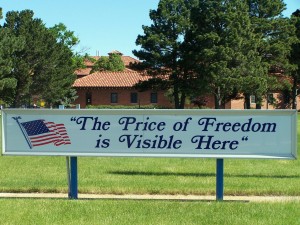Jan
30
Healing Ain’t Easy
Filed Under Treating PTSD
Hello everyone. We have been back from our trip to Vietnam/Cambodia for ten days now. Getting our sleep patterns to normalize has been more challenging than getting our daily routines into a new rhythm. Before we left, I mentioned that we learned a few breathing strategies to use just in case Tony was triggered by a sight, sound, smell… from combat. Tony admitted that the breathing was useful on a few occasions, but he never felt that any of the experiences were overwhelming – another milestone in the lifetime journey of healing. Yea! Yesterday, we went to Cheyenne for a second session of EMDR (Eye Movement Desensitization and Reprocessing) with a veteran’s service therapist. EMDR has been used since the 1980’s with individuals who have experienced a wide range of traumatic events ranging from car accidents, rape, domestic violence… and combat PTSD. The purpose of EMDR is to help the individual reprocess the event in a manner that is not as emotionally volatile, thereby, reconciling the experience into something that is more acceptable to the sufferer. Truthfully, we do not know if this particular type of therapy will work with Tony’s PTSD, but it is worth a try. We know of many non-vets who have told us stories of how EMDR helped them. Since I am being allowed to be part of these sessions, I have already had a few significant Aha moments. The first is getting the patient to move from a cognitive processing mode (in the head) to a feeling mode (in the body), which can be incredibly difficult. Modern man (and woman) has an enormous need to control his environment. It makes us all feel a bit safer when we believe in this illusion of “control”. To move from analyzing everything we experience through our heads and think about how our body is responding; i.e., anxiousness, faster heartbeats, headaches, stomach cramps… is something not many of us think about on a regular basis. In fact, we often take a pill to make the emotional cramping go away. EMDR’s focus is on the “body feeling”. In neuroscience terms, it is an attempt to get both body and mind in closer alignment which, hopefully, allows a person to live in a healthier state of being. The second Aha for me was this: The full impact of a stressful event isn’t when the traumatic event took place, i.e., the utter horror of combat, the killing, the IED explosion…It begins far before that event. It begins before the person landed in the foreign country, got into the car, or encountered the threat. All of the sensory information that came before the actual event were also encoded into the body/brain. So Tony’s beginning started when he received his orders to go to Vietnam: as he boarded the plane, when he first walked off the plane, and when he was being processed in Vietnam for his combat assignment. Wow, what a revelation this was to both of us. I thought that we were only dealing with the trauma from the really terrible experiences. No wonder this thing we call PTSD is so powerful and full of ghosts. It began sooner and there were more ghosts than we ever imagined. No wonder so many vets aren’t excited about therapy. It is enormously difficult, scary, and unsettling work. Not only does it take huge amounts of courage and persistence, it takes a strong support system to stand beside, listen, and observe the wounded. This part of the healing journey may be more complex than we ever thought. I’ll keep you posted as we take one small step at a time. I’m thinking this may be a good time to stock up on comfort food and lots of dark chocolate.


